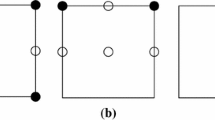Abstract
Deterministic Galerkin approximations of a class of second order elliptic PDEs with random coefficients on a bounded domain D⊂ℝd are introduced and their convergence rates are estimated. The approximations are based on expansions of the random diffusion coefficients in L 2(D)-orthogonal bases, and on viewing the coefficients of these expansions as random parameters y=y(ω)=(y i (ω)). This yields an equivalent parametric deterministic PDE whose solution u(x,y) is a function of both the space variable x∈D and the in general countably many parameters y.
We establish new regularity theorems describing the smoothness properties of the solution u as a map from y∈U=(−1,1)∞ to \(V=H^{1}_{0}(D)\). These results lead to analytic estimates on the V norms of the coefficients (which are functions of x) in a so-called “generalized polynomial chaos” (gpc) expansion of u.
Convergence estimates of approximations of u by best N-term truncated V valued polynomials in the variable y∈U are established. These estimates are of the form N −r, where the rate of convergence r depends only on the decay of the random input expansion. It is shown that r exceeds the benchmark rate 1/2 afforded by Monte Carlo simulations with N “samples” (i.e., deterministic solves) under mild smoothness conditions on the random diffusion coefficients.
A class of fully discrete approximations is obtained by Galerkin approximation from a hierarchic family \(\{V_{l}\}_{l=0}^{\infty}\subset V\) of finite element spaces in D of the coefficients in the N-term truncated gpc expansions of u(x,y). In contrast to previous works, the level l of spatial resolution is adapted to the gpc coefficient. New regularity theorems describing the smoothness properties of the solution u as a map from y∈U=(−1,1)∞ to a smoothness space W⊂V are established leading to analytic estimates on the W norms of the gpc coefficients and on their space discretization error. The space W coincides with \(H^{2}(D)\cap H^{1}_{0}(D)\) in the case where D is a smooth or convex domain.
Our analysis shows that in realistic settings a convergence rate \(N_{\mathrm{dof}}^{-s}\) in terms of the total number of degrees of freedom N dof can be obtained. Here the rate s is determined by both the best N-term approximation rate r and the approximation order of the space discretization in D.
Similar content being viewed by others
References
I. Babuška, R. Tempone, G.E. Zouraris, Galerkin finite element approximations of stochastic elliptic partial differential equations, SIAM J. Numer. Anal. 42, 800–825 (2004).
I. Babuška, F. Nobile, R. Tempone, A stochastic collocation method for elliptic partial differential equations with random input data, SIAM J. Numer. Anal. 45, 1005–1034 (2007).
P.G. Ciarlet, The Finite Element Methods for Elliptic Problems (Elsevier, Amsterdam, 1978).
A. Cohen, Numerical Analysis of Wavelet Methods (Elsevier, Amsterdam, 2003).
A. Cohen, W. Dahmen, R. DeVore, Adaptive wavelet methods for elliptic operator equations—convergence rates, Math. Comput. 70, 27–75 (2001).
A. Cohen, R. DeVore, C. Schwab, Analytic regularity and polynomial approximation of parametric and stochastic elliptic PDE’s, Anal. Appl. (2010, to appear).
R. DeVore, Nonlinear approximation, Acta Numer. 7, 51–150 (1998).
T. Gantumur, H. Harbecht, R. Stevenson, An adaptive wavelet method without coarsening of the iterands, Math. Comput. 76, 615–629 (2007).
R. Ghanem, P. Spanos, Spectral techniques for stochastic finite elements, Arch. Comput. Methods Eng. 4, 63–100 (1997).
G.E. Karniadakis, D.B. Xiu, The Wiener-Askey polynomial chaos for stochastic differential equations, SIAM J. Sci. Comput. 24, 619–644 (2002).
M. Kleiber, T.D. Hien, The Stochastic Finite Element Methods (Wiley, New York, 1992).
M. Ledoux, M. Talagrand, Probability in Banachspaces. Ergebnisse der Mathematik und ihrer Grenzgebiete, vol. 23 (Verlag, Berlin, 1991).
F. Nobile, R. Tempone, C.G. Webster, A sparse grid stochastic collocation method for elliptic partial differential equations with random input data, SIAM J. Numer. Anal. 46, 2309–2345 (2008).
F. Nobile, R. Tempone, C.G. Webster, An anisotropic sparse grid stochastic collocation method for elliptic partial differential equations with random input data, SIAM J. Numer. Anal. 46, 2411–2442 (2008).
G. Rozza, D.B.P. Huynh, A.T. Patera, Reduced basis approximation and a posteriori error estimation for affinely parametrized elliptic coercive partial differential equations and application to transport and continuum mechanics, Arch. Comput. Methods Eng. 15, 229–275 (2008).
W. Schoutens, Stochastic Processes and Orthogonal Polynomials. Lecture Notes in Statistics, vol. 146 (Springer, New York, 2000).
C. Schwab, R. Todor, Karhúnen–Loève approximation of random fields by generalized fast multipole methods, J. Comput. Phys. 217, 100–122 (2006).
S.A. Smolyak, Quadrature and interpolation formulas for tensor products of certain classes of functions, Dokl. Akad. Nauk SSSR 4, 240–243 (1963).
R. Todor, Robust eigenvalue computation for smoothing operators, SIAM J. Numer. Anal. 44, 865–878 (2006).
R. Todor, C. Schwab, Convergence rates for sparse chaos approximations of elliptic problems with stochastic coefficients, IMA J. Numer. Anal. 45, 232–261 (2007).
T. von Petersdorff, C. Schwab, Sparse finite element methods for operator equations with stochastic data, Appl. Math. 51, 145–180 (2006).
N. Wiener, The homogeneous chaos, Am. J. Math. 60, 897–936 (1938).
Author information
Authors and Affiliations
Corresponding author
Additional information
Communicated by Wolfgang Dahmen.
This research was supported by the Fondation Sciences Mathématiques de Paris; the Office of Naval Research Contracts ONR-N00014-08-1-1113, ONR N00014-09-1-0107; the AFOSR Contract FA95500910500; the NSF Grant DMS-0810869; the Swiss National Science Foundation under Grant No. 200021-120290/1 and European Research Council Project No. 247277.
Rights and permissions
About this article
Cite this article
Cohen, A., DeVore, R. & Schwab, C. Convergence Rates of Best N-term Galerkin Approximations for a Class of Elliptic sPDEs. Found Comput Math 10, 615–646 (2010). https://doi.org/10.1007/s10208-010-9072-2
Received:
Accepted:
Published:
Issue Date:
DOI: https://doi.org/10.1007/s10208-010-9072-2
Keywords
- Stochastic and parametric elliptic equations
- Wiener polynomial chaos
- Approximation rates
- Nonlinear approximation
- Sparsity




